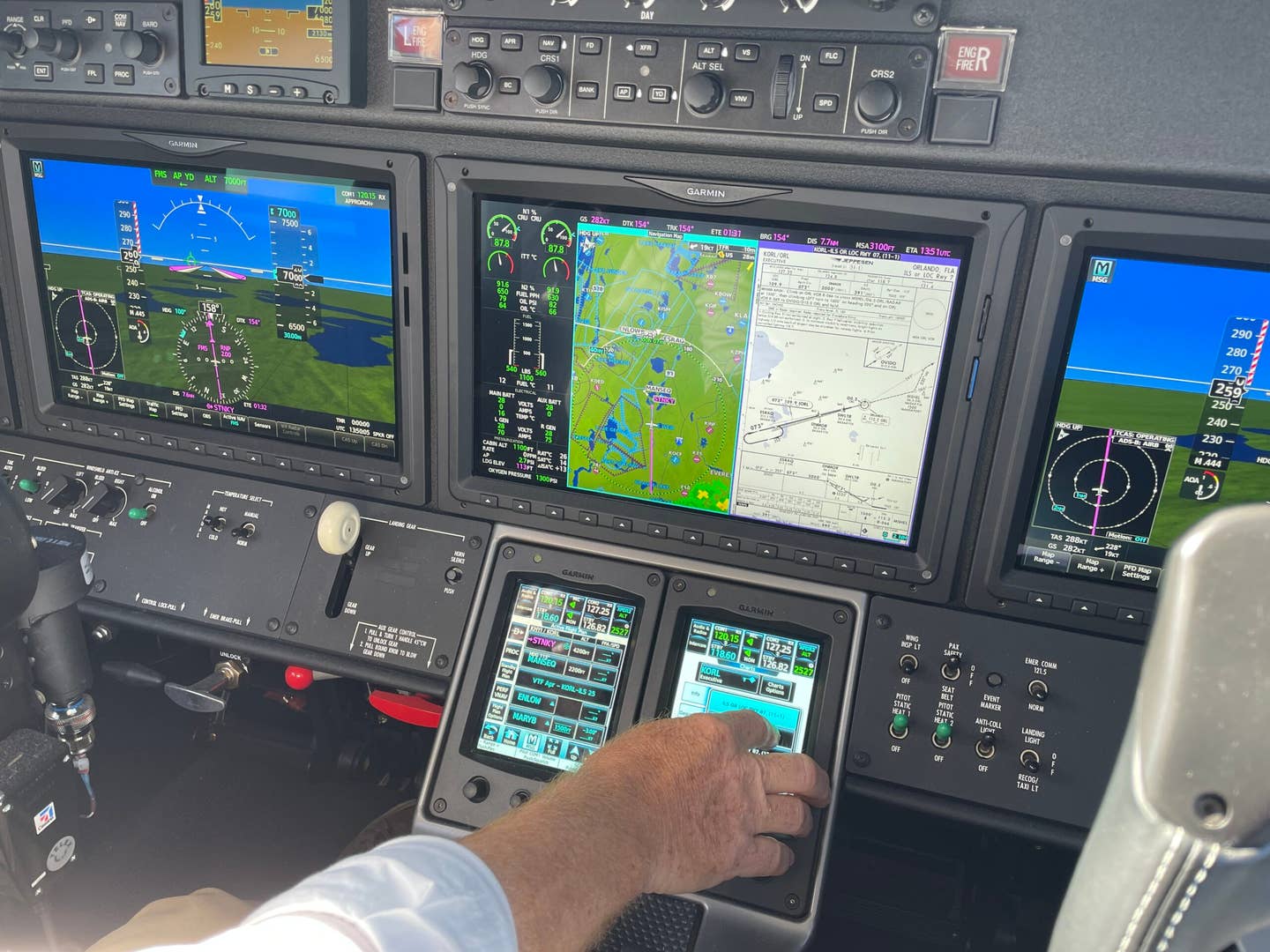Garmin Reaches a Flight Deck Milestone
Since 2003, the avionics giant has delivered more than 25,000 systems. What does this mean for pilots?

The standard G3000 avionics suite in a Cessna Citation M2. [Photo: Julie Boatman]
Over the course of two weeks this month, I will have flown in three different general aviation airplanes with Garmin’s (NASDAQ: GRMN) integrated flight decks installed in the panel:
- A Cessna 182 with the G1000 Nxi factory-installed—a piston single that represents the next generation of Garmin’s first OEM installations in the 2004 Skylane.
- A Cessna Citation M2 with the standard G3000 avionics suite—a light jet with a flight deck optimized for single-pilot operation.
- A Beechcraft King Air 350 with a G1000 Nxi aftermarket installation—a workhorse turboprop twin taking on a new life.
You could count a fourth airplane too—a SOCATA TB-30 Epsilon that I regularly get to fly, that hosts a Garmin G3X Touch in an experimental/exhibition application, turning a French military trainer into a solid IFR traveling machine.
“...it’s becoming more and more likely that the transition you make between airplanes moves you from one Garmin display and navigation engine to another—and you learn the airplane around them.”
The point is, you can’t swing a dead cat without hitting a Garmin flight deck these days. Not that you would want to hurt a kitty or an airplane in the process…Garmin Aviation can take a bow for creating a relatively user-friendly product backed up by solid OEM development on the front end, and support on the back end.
This week, the company is celebrating a milestone that illustrates why we’re now finding its flight decks everywhere: It has delivered more than 25,000 total since the first G1000 left the plant in Olathe, Kansas.
A Nod to Gary Burrell
Garmin’s late co-founder Gary Burrell had the concept in his mind of what the original G1000 avionics suite would look like. The original installation consisted of a primary flight display and multifunction display (two GDU 1040s) driven by two Garmin Integrated Avionics units (GIA 63s), and a Garmin GMA 1347 audio panel. Internally, other components included the air data computer (GDC74A), attitude heading and reference system (GRS 77 AHRS), and a magnetometer (GMU 44). These parts in their subsequent evolutions still form the basis of the flight decks Garmin has debuted since March 2003—when Cessna Aircraft Company announced it had selected the G1000 for its new Citation Mustang, aimed originally at the very light jet (VLJ) market.
“Pilots around the world have spent millions of hours flying behind a Garmin flight deck and it’s a true privilege to know that our avionics help them safely reach their destinations time and time again,” said Phil Straub, Garmin executive vice president and managing director, aviation, in a release this week. “As the leading provider of integrated cockpit systems, we are very proud to celebrate this extraordinary achievement, and we wish to extend our sincerest gratitude to our aircraft manufacturers, as well as the aircraft owners, who have selected and trusted Garmin over the years.
“The G1000 was a vision of our late co-founder Gary Burrell,” Straub continued, “and he would be deeply honored to be celebrating this milestone with the thousands of talented Garmin associates who made it possible.”
We've delivered 25,000 integrated flight decks! Thanks to our customers and partners for helping us reach this milestone 🤝
— Garmin Aviation (@GarminAviation) June 15, 2022
Which Garmin IFDs have you flown behind?
☐ G1000 NXi
☐ G2000
☐ G3000
☐ G5000 pic.twitter.com/skelhd5LG0
What It Means to Pilots
Turn the clock back 30 years, and life wasn’t all that different, in terms of consistency from a flight instrument perspective. You could train in a basic airplane, such as a Cessna 152, and learn attitude instrument flight and transfer that skill—and your scan—to a new airplane with just a few adjustments to make.
That is, if you consider the standard six-pack of analog gauges—attitude indicator, airspeed indicator, heading indicator, vertical speed indicator, turn coordinator, and altimeter—to be essentially the same between single-engine airplanes. Which they are not, really. But they were straightforward, and WYSIWYG (what you see is what you get) applied. The radio stack had similar nav/coms—and if you were lucky, there was a King autopilot or a loran receiver to learn. And that was it.
We went through a phase—and we’re still there, really—where the fleet’s panels were truly mixed, with airplanes equipped with glass PFDs sitting on the ramp next to those with six packs, even within a flight school’s fleet. With Garmin’s market penetration, it’s becoming more and more likely that the transition you make between airplanes moves you from one Garmin display and navigation engine to another—and you learn the airplane around them. And think, too, of the power behind those displays, and the sheer amount of information now at our fingertips. That has had an impact on safety, to which Straub justifiably refers.
If only it were that simple, though. The similarities are deceptive—and can catch you unaware if you stick to the idea that one G3000 installation mirrors exactly the one next to it. Many things will be the same, but there are still nuances to learn between, say, the G3000 in the TBM 960 and the one in the M2. As Murphy would have it, those details will catch you when you’re in the weather, bouncing around into a missed approach, and running into your reserve fuel.
More competition in the space might drive more user-friendly system architecture as well. A common lament from those transitioning from sophisticated flight management systems such as the Collins Pro Line series is that the Garmins do it almost right—but there are strange gaps in the transfer of data, where values must be entered manually into fields that would populate automatically in the Collins FMS.
But kudos to Garmin for making a product line with the iterations to fit a wide range of general aviation applications—and we can only anticipate how they’ll improve on that success.

Sign-up for newsletters & special offers!
Get the latest FLYING stories & special offers delivered directly to your inbox






